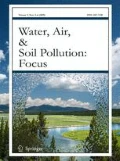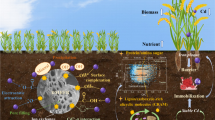Abstract
The addition of straw in combination with ‘Carbokalk’, a by-product from the sugar-industry, was successfully used to stimulate microbial alkalinity generation in an acidic mining lake. To get detailed information about functions of straw, anenclosure experiment was carried out. Straw bundles were placedat the sediment surface of an acidic mining lake (ML 111) and thephysiochemical conditions and the microbiology of the sediment-water contact zone were studied. Straw was degraded by anaerobic microorganisms and dissolved organic carbon (DOC) leached from straw bundles. Pigmented flagellates responded to the DOC supply in the water column anda considerable amount of algal carbon was transported to the sediment. Straw addition led to microbial reduction of iron andsulfate in the sediment. Sulfate reduction was observed at a pHof 5.5. The pH, however, was not high enough to precipitate H2S completely. Thus, some H2S diffused into the watercolumn, where it was reoxidized. Straw did not create orstabilize an anoxic water body above the sediment. Microbial sulfate reduction and pyrite formation only took place in the sediment,whereas iron reduction also took place in the straw. Straw, however, altered the flow conditions above the sediment surfaceand prevented complete mixing of the profundal water. Straw didnot serve as a substratum for a reactive biofilm. We conclude that the most important function of straw for mining lake remediation is to be a long-term nutrient source for microbialalkalinity generation in the sediment.
Similar content being viewed by others
References
Bissinger, V., Jander, J. and Tittel, J.: 2000, ‘A New Medium Free of Organic Carbon to Cultivate Organisms from Extremely Acidic Mining Lakes (pH 2.7)’, Acta Hydrochim. Hydrobiol. 28, 310–312.
Brock, T. D. and Gustafson, J.: 1976, ‘Ferric Iron Reduction by Sulfur-and Iron Oxidizing Bacteria’, Appl.Env.Microb. 32, 567–571.
Brugam, R. B., Gastineau, J. and Ratcliff, E.: 1995, ‘The Neutralization of Acidic Coal Mine Lakes by Addition of Natural Organic matter: A Mesocosm Test’, Hydrobiologia 316, 153–159.
Chang, I. S., Shin, P. K. and Kim, B. H.: 2000, ‘Biological Treatment of Acid Mine Drainage under Sulphate-reducing Conditions with Solid Waste Materials as Substrate’, Wat. Res. 34, 1269–1277.
Christensen, B., Laake, M. and Lien, T.: 1996, ‘Treatment of Acid Mine Water by Sulfate Reducing Bacteria: Results from a Bench Scale Experiment’, Wat. Res. 30, 1617–1624.
Dobbin, P. S., Carter, J. P., García-Salamanca San Juan, C., Von Jobe, M., Powell, A. K. and Richardson, D. J.: 1999, ‘Dissimilatory Fe(III) Reduction by Clostridium beijerinckii isolated from Freshwater Sediment using Fe(III) Maltol Enrichment’, FEMS Microbiol. Lett. 176, 131–138.
Drury, W. J.: 1999, ‘Treatment of Acid Mine Drainage with Anaerobic Solid-substrate Reactors’, Wat er Env. Res. 71, 1244–1250.
Dvorak, D. H., Hedin, R. S., Edenborn, H. M. and McIntire, P. E.: 1992, ‘Treatment of Metal-containing Water using Bacterial Sulfate Reduction: Results from Pilot-scale Reactors’, Biotech. Bioeng. 40, 609–616.
Friese, K., Wendt-Potthoff, K., Zachmann, D. W., Fauville, A., Mayer, B. and Veizer, J.: 1998, ‘Biogeochemistry of Iron and Sulfur in Sediments of an Acidic Mining Lake in Lusatia, Germany’, Water, Air, and Soil Pollut. 108, 231–247.
Frömmichen, R.: 2001, ‘In Situ-Sanierungsstrategie zur Förderung der Mikrobiellen Entsäuerung von Geogen Schwefelsauren Bergbaurestseen - Mesokosmostudien’, Ph.D. Thesis, Technical University of Dresden, UFZ-Bericht 12/2001, Leipzig, 155 pp. (in German).
Kühl, M., Steuckart, C., Eickert, G. and Jeroschewski, P.: 1998, ‘A H2S Microsensor for Profiling Biofilms and Sediments: Application in an Acidic Lake Sediment’, Aquat. Microb. Ecol. 15, 201–209.
Küsel, K., Dorsch, T., Acker, G. and Stackebrandt, E.: 1999, ‘Microbial Reduction of Fe(III) in Acidic Sediments: Isolation of Acidiphilium cryptum JF-5 Capable of Coupling the Reduction of Fe(III) to the Oxidation of Glucose’, Appl. Environ. Microbiol. 51(4), 683–689.
L'air Liquide: 1976, Enzyclopedie des Gaz, Elsevier, New York.
Lovley, D. R. and Phillips, E. J. P.: 1987, ‘A Rapid Assay for Microbially Reducible Ferric Iron in Aquatic Sediments’, Appl. Env. Microbiol. 53, 1536–1540.
Meier, J., Voigt, A. and Babenzien, H. D.: 2000, ‘A Comparison of 35S-SO 2—4 Radiotracer Techniques to Determine Sulphate Reduction Rates in Laminated Sediments’, J. Microbiol. Meth. 41, 9–18.
Szilágyi, M.: 1971, ‘Reduction of Fe3+ Ion by Humic Acid Preparations’, Soil Science 111, 233–235.
Vile, M. A. and Wieder, R. K.: 1993, ‘Alkalinity Generation by FeIII Reduction versus Sulfate Reduction in Wetlands Constructed for Acid Mine Drainage Treatment’, Water, Air, and Soil Pollut. 69, 425–441.
Wendt-Potthoff, K. and Koschorreck, M.: 2002, ‘Functional Groups and Activities of Bacteria in a Highly Acidic Volcanic Mountain Stream and Lake in Patagonia, Argentina’, Microb. Ecol. 43, 92–106.
Author information
Authors and Affiliations
Corresponding author
Rights and permissions
About this article
Cite this article
Koschorreck, M., Frömmichen, R., Herzsprung, P. et al. Functions of Straw for In Situ Remediation of Acidic Mining Lakes. Water, Air, & Soil Pollution: Focus 2, 97–109 (2002). https://doi.org/10.1023/A:1019991326498
Issue Date:
DOI: https://doi.org/10.1023/A:1019991326498




